

Compact Muon Solenoid
LHC, CERN
| CMS-EXO-16-058 ; CERN-EP-2018-001 | ||
| Search for lepton-flavor violating decays of heavy resonances and quantum black holes to e$\mu$ final states in proton-proton collisions at $\sqrt{s} = $ 13 TeV | ||
| CMS Collaboration | ||
| 4 February 2018 | ||
| JHEP 04 (2018) 073 | ||
| Abstract: A search is reported for heavy resonances decaying into e$\mu$ final states in proton-proton collisions recorded by the CMS experiment at the CERN LHC at $\sqrt{s} = $ 13 TeV, corresponding to an integrated luminosity of 35.9 fb$^{-1}$. The search focuses on resonance masses above 200 GeV. With no evidence found for physics beyond the standard model in the e$\mu$ mass spectrum, upper limits are set at 95% confidence level on the product of the cross section and branching fraction for this lepton-flavor violating signal. Based on these results, resonant ${\tau}$ sneutrino production in R-parity violating supersymmetric models is excluded for masses below 1.7 TeV, for couplings $\lambda_{132}=\lambda_{231}=\lambda'_{311}= $ 0.01. Heavy Z' gauge bosons with lepton-flavor violating transitions are excluded for masses up to 4.4 TeV. The e$\mu$ mass spectrum is also interpreted in terms of non-resonant contributions from quantum black-hole production in models with one to six extra spatial dimensions, and lower mass limits are found between 3.6 and 5.6 TeV. In all interpretations used in this analysis, the results of this search improve previous limits by about 1 TeV. These limits correspond to the most sensitive values obtained at colliders. | ||
| Links: e-print arXiv:1802.01122 [hep-ex] (PDF) ; CDS record ; inSPIRE record ; HepData record ; CADI line (restricted) ; | ||
| Figures | |

png pdf |
Figure 1:
Leading order Feynman diagrams considered in our search. Left: Resonant production of a $ \tau $ sneutrino in an RPV SUSY model that includes the subsequent decay into an electron and a muon. The $\nu_{\tau}$ is produced from the annihilation of two down quarks via the $\lambda'_{311}$ coupling, and then decays via the $\lambda_{132} = \lambda_{231}$ couplings into the electron muon final state. Middle: Production of quantum black holes in a model with extra dimensions that involves subsequent decay into an electron and a muon. Right: Resonant production of a Z' boson with subsequent decay into an electron and a muon |
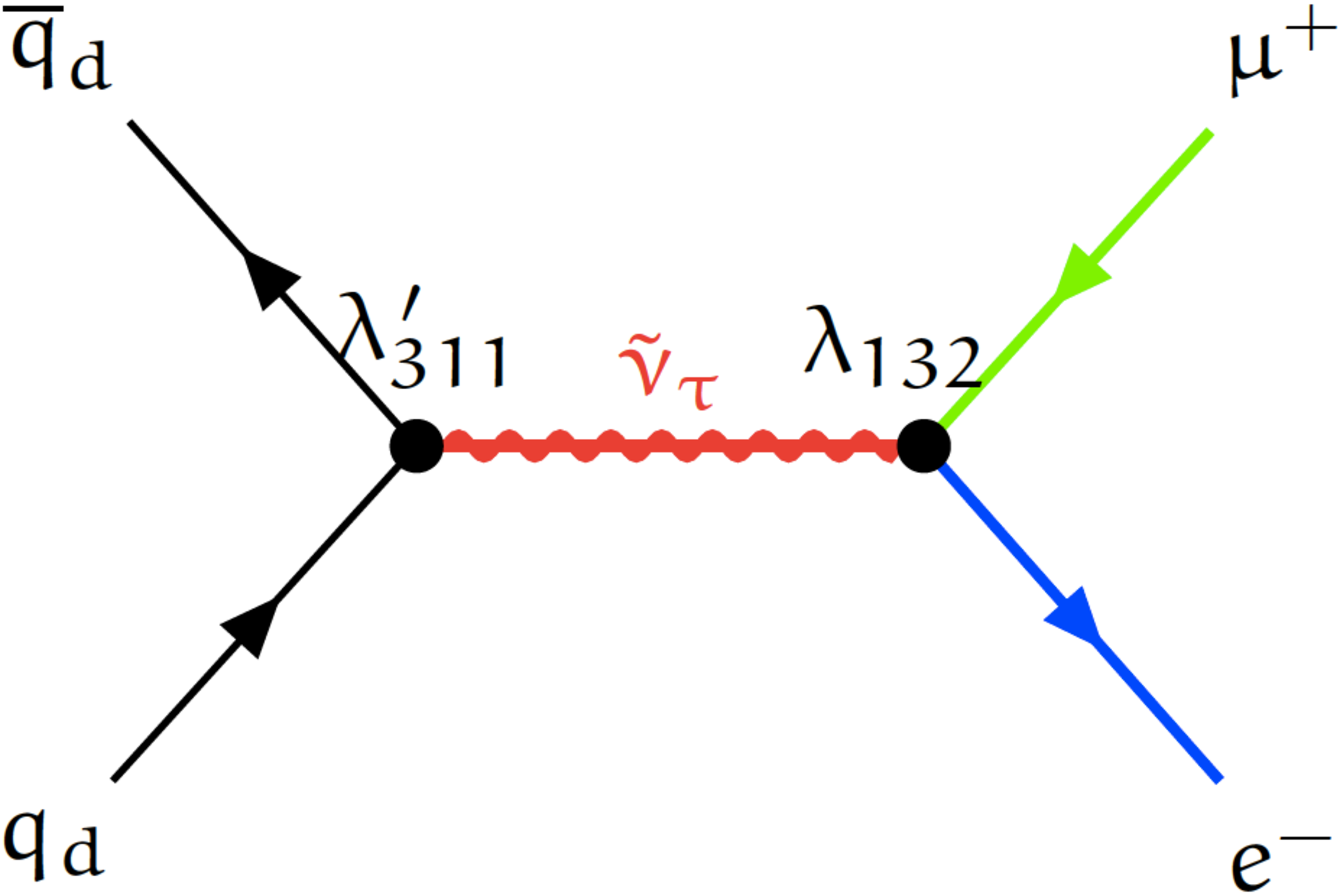
png pdf |
Figure 1-a:
Leading order Feynman diagram considered in our search: Resonant production of a $ \tau $ sneutrino in an RPV SUSY model that includes the subsequent decay into an electron and a muon. The $\nu_{\tau}$ is produced from the annihilation of two down quarks via the $\lambda'_{311}$ coupling, and then decays via the $\lambda_{132} = \lambda_{231}$ couplings into the electron muon final state. |

png pdf |
Figure 1-b:
Leading order Feynman diagram considered in our search: Production of quantum black holes in a model with extra dimensions that involves subsequent decay into an electron and a muon. |

png pdf |
Figure 1-c:
Leading order Feynman diagram considered in our search: Resonant production of a Z' boson with subsequent decay into an electron and a muon. |
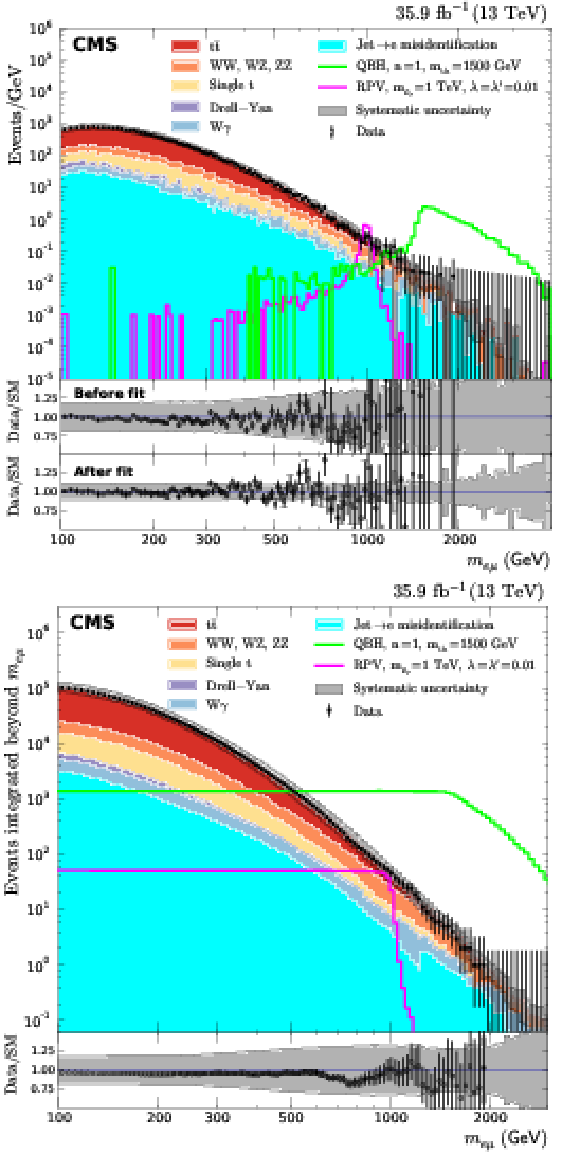
png pdf |
Figure 2:
Upper: The invariant mass distribution for selected e$\mu$ pairs in data (black points with error bars), and stacked histograms representing expectations from SM processes before the fit. Also shown are the expectations for two possible signals. The two lower panels show the ratio of data to background expectations before and after the fit. The total systematic uncertainties are given by the gray bands. Lower: The cumulative (integral) distribution in events integrated beyond the chosen $m_{{\mathrm {e}} {{\mu}}}$. The lower panel shows the ratio of data to background predictions before the fit. Some events in the invariant mass distribution can have a negative event weight and result in a rise of the cumulative mass distribution. In both figures the label $\lambda $ refers to $\lambda _{132} = \lambda _{231}$, while $\lambda '$ stands for $\lambda '_{311}$. |

png pdf |
Figure 2-a:
The invariant mass distribution for selected e$\mu$ pairs in data (black points with error bars), and stacked histograms representing expectations from SM processes before the fit. Also shown are the expectations for two possible signals. The two lower panels show the ratio of data to background expectations before and after the fit. The total systematic uncertainties are given by the gray bands. The label $\lambda $ refers to $\lambda _{132} = \lambda _{231}$, while $\lambda '$ stands for $\lambda '_{311}$. |
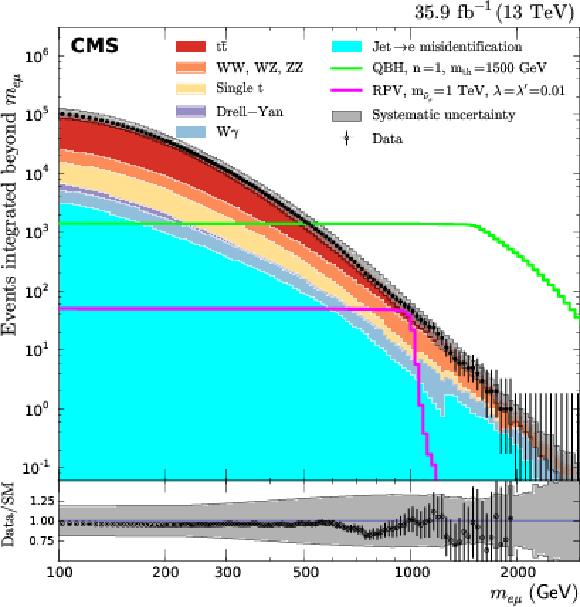
png pdf |
Figure 2-b:
The cumulative (integral) distribution in events integrated beyond the chosen $m_{{\mathrm {e}} {{\mu}}}$. The lower panel shows the ratio of data to background predictions before the fit. Some events in the invariant mass distribution can have a negative event weight and result in a rise of the cumulative mass distribution. The label $\lambda $ refers to $\lambda _{132} = \lambda _{231}$, while $\lambda '$ stands for $\lambda '_{311}$. |
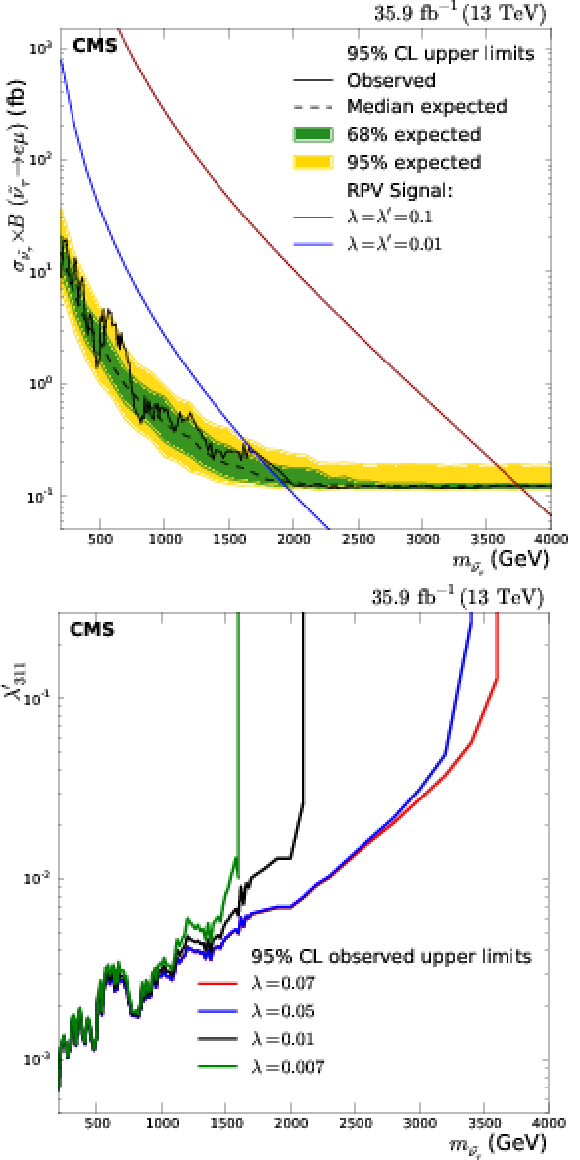
png pdf |
Figure 3:
Upper: Upper limits at 95% CL on the product of the signal cross section and branching fraction for the $ \tilde{\nu}_ {\tau}$ signal, as a function of the mass of the RPV resonance. The 68 and 95% CL intervals on the median expected limits are indicated, respectively, by the inner green and outer yellow shadings. Predictions for an RPV SUSY model are shown for two values of the coupling parameter. Lower: Upper limits at 95% CL on the RPV $ \tilde{\nu}_ {\tau}$ signal in the $(m_{\tilde{\nu}_ {\tau}},\lambda '_{311})$ parameter plane, for four values of $\lambda $, where the regions to the left of and above the limits are excluded. In both figures $\lambda $ refers to $\lambda _{132} = \lambda _{231}$, while $\lambda '$ stands for $\lambda '_{311}$. |
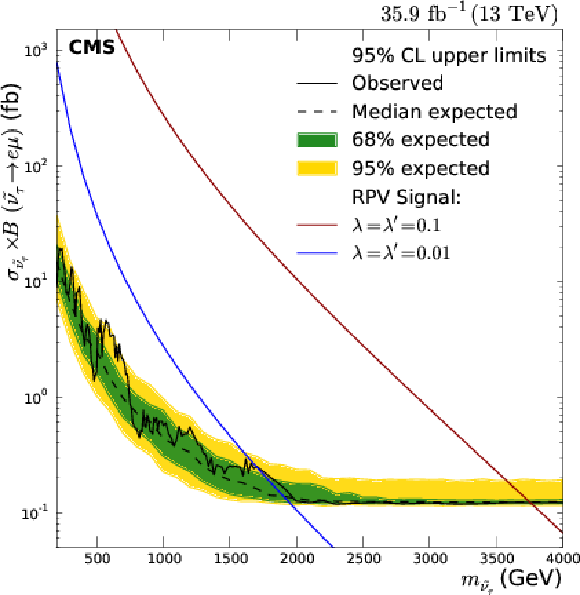
png pdf |
Figure 3-a:
Upper limits at 95% CL on the product of the signal cross section and branching fraction for the $ \tilde{\nu}_ {\tau}$ signal, as a function of the mass of the RPV resonance. The 68 and 95% CL intervals on the median expected limits are indicated, respectively, by the inner green and outer yellow shadings. Predictions for an RPV SUSY model are shown for two values of the coupling parameter. $\lambda $ refers to $\lambda _{132} = \lambda _{231}$, while $\lambda '$ stands for $\lambda '_{311}$. |
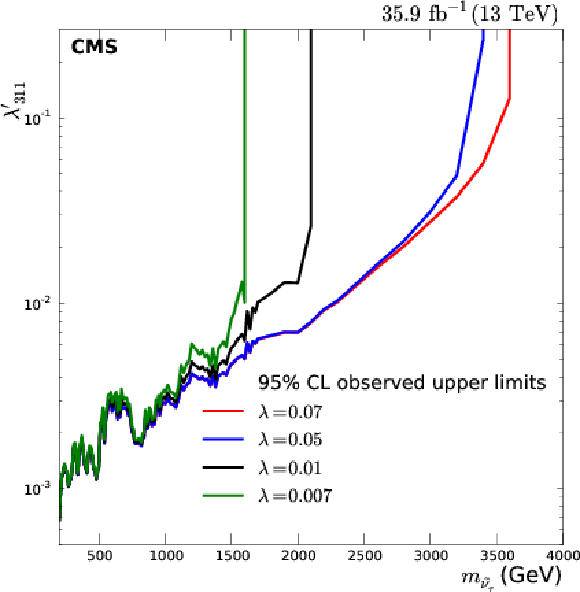
png pdf |
Figure 3-b:
Upper limits at 95% CL on the RPV $ \tilde{\nu}_ {\tau}$ signal in the $(m_{\tilde{\nu}_ {\tau}},\lambda '_{311})$ parameter plane, for four values of $\lambda $, where the regions to the left of and above the limits are excluded. $\lambda $ refers to $\lambda _{132} = \lambda _{231}$, while $\lambda '$ stands for $\lambda '_{311}$. |
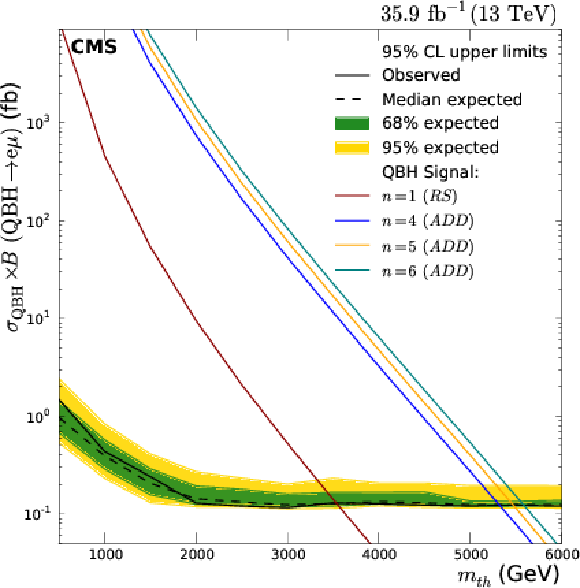
png pdf |
Figure 4:
Upper limits at 95% CL on the median product of the signal cross section and the branching fraction for the QBH decay to e$\mu$ as a function of threshold mass $m_\text {th}$. The 68 and 95% CL intervals on the median are indicated, respectively, by the inner green and outer yellow shadings. Predictions are also shown for several models with large extra spatial dimensions, specifically for 1 extra dimension (RS) and for 4, 5, and 6 extra dimensions (ADD). |
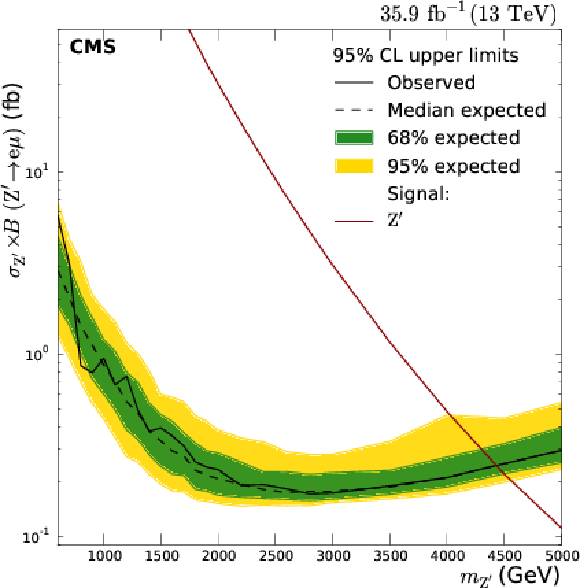
png pdf |
Figure 5:
The upper limits at 95% CL on the product of the signal cross section and the branching fraction, assuming $\mathcal {B} = $ 10% for the decay $ {\mathrm {Z}'} \to {\mathrm {e}} {{\mu}}$, as a function of $m_{{\mathrm {Z}'}}$. The 68 and 95% CL intervals on the median are indicated, respectively, by the inner green and outer yellow shadings. |
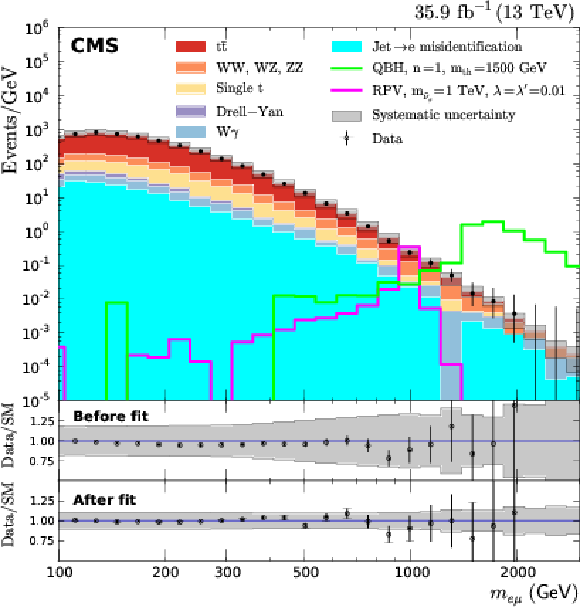
png pdf |
Figure 6:
Invariant mass of the e$\mu$ pair for all events that pass the event selection criteria. In the lower panels, we show the ratio of the data to the before-fit and after-fit background predictions, including uncertainties. The label $\lambda$ stands for $\lambda_{132} = \lambda_{231}$, while $\lambda'$ stands for $\lambda'_{311}$. The content is the same as in Fig. 2, but with a coarser binning. |

png pdf |
Figure 7:
Efficiency of the RPV signal for all events after the acceptance requirements (light blue triangular points), after acceptance and trigger requirements (magenta square points), and after the full selection, which includes acceptance and trigger criteria (red round points). The reconstruction efficiency is also included, with the product of the final acceptance and efficiency parametrized for the statistical interpretation by a function illustrated by the black line. The systematic uncertainties are obtained by propagating the effect of the systematic uncertainties to the efficiency. The systematically shifted upper and lower efficiency points are not shown in the figure, but just the parametrization of both dependencies, with upward shifts in dotted green and downward shifts in dashed orange. |

png pdf |
Figure 8:
Relative mass resolution for all e$\mu$ pairs, obtained through simulation of the RPV signal, from the reconstructed mass $m_{\mathrm{e}\mu,\text{reco}}$ and the generated mass $m_{\mathrm{e}\mu,\text{gen}}$, as a function of the generated mass. The effect of the systematic uncertainties on the mass resolution is shown. The systematically shifted upper and lower mass resolutions are shown in the figure with the corresponding parametrization for the upward shifts in dotted green and the downward shifts in dashed orange. |
| Tables | |

png pdf |
Table 1:
Numbers of events for background processes, total background with its associated systematic uncertainties, and data, in four bins of e$\mu$ invariant mass. |

png pdf |
Table 2:
Parametrization functions for the product of the acceptance and efficiency, and for the invariant mass resolution for the RPV signal. The value of $m_{\tilde{\nu}_ {\tau}}$ is given in units of GeV. The functions are shown in Figs. 7 and 8. |
| Summary |
| A search for heavy resonances decaying into e$\mu$ pairs has been carried out in proton-proton collisions, recorded with the CMS detector at the LHC at a center-of-mass energy of 13 TeV, corresponding to an integrated luminosity of 35.9 fb$^{-1}$. Good agreement is observed between the data and the standard model expectation. Limits are set on the resonant production of ${\tau}$ sneutrinos ($\nu_{\tau}$) in R-parity violating supersymmetric models. For couplings $\lambda_{132} = \lambda_{231} = \lambda'_{311} = 0.01$ and 0.1, a $\nu_{\tau}$ is excluded for masses below 1.7 and 3.8 TeV respectively, assuming it is the lightest supersymmetric particle. Lower limits of 5.3, 5.5, and 5.6 TeV are set on the threshold mass of quantum black holes in a model with 4, 5, and 6 large extra spatial dimensions, respectively. For the model with a single, warped extra spatial dimension, the lower limit on the threshold mass is 3.6 TeV. Also, a Z' boson with a 10% branching fraction to the e$\mu$ channel is excluded for masses below 4.4 TeV. In all cases, the results of this search improve the previous lower limits by about 1 TeV. |
| References | ||||
| 1 | G. R. Farrar and P. Fayet | Phenomenology of the production, decay, and detection of new hadronic states associated with supersymmetry | PLB 76 (1978) 575 | |
| 2 | F. de Campos et al. | CERN LHC signals for neutrino mass model in bilinear R-parity violating mAMSB | PRD 77 (2008) 115025 | 0803.4405 |
| 3 | A. Bartl et al. | CP phases, LFV, RPV and all that | in Linear colliders. Proceedings, International Workshop on physics and experiments with future electron-positron linear colliders, LCWS 2002, Seogwipo, Jeju Island, Korea, August 26-30, 2002 2003 | hep-ph/0301027 |
| 4 | R. Barbier et al. | R-parity violating supersymmetry | PR 420 (2005) 1 | hep-ph/0406039 |
| 5 | P. Langacker | The physics of heavy $ Z^\prime $ gauge bosons | Rev. Mod. Phys. 81 (2009) 1199 | 0801.1345 |
| 6 | X. Calmet, W. Gong, and S. D. H. Hsu | Colorful quantum black holes at the LHC | PLB 668 (2008) 20 | 0806.4605 |
| 7 | P. Meade and L. Randall | Black holes and quantum gravity at the LHC | JHEP 05 (2008) 003 | 0708.3017 |
| 8 | P. W. Graham, D. E. Kaplan, S. Rajendran, and P. Saraswat | Displaced supersymmetry | JHEP 07 (2012) 149 | 1204.6038 |
| 9 | D. M. Gingrich | Quantum black holes with charge, colour, and spin at the LHC | JPG 37 (2010) 105008 | 0912.0826 |
| 10 | L. Randall and R. Sundrum | A large mass hierarchy from a small extra dimension | PRL 83 (1999) 3370 | hep-ph/9905221 |
| 11 | N. Arkani-Hamed, S. Dimopoulos, and G. R. Dvali | The hierarchy problem and new dimensions at a millimeter | PLB 429 (1998) 263 | hep-ph/9803315 |
| 12 | CDF Collaboration | Search for R-parity violating decays of $ \tau $ sneutrinos to $ \mathrm{e}\mu $, $ \mu\tau $, and $ \mathrm{e}\tau $ pairs in $ \mathrm{p\bar{p}} $ collisions at $ \sqrt{s} = $ 1.96 TeV | PRL 105 (2010) 191801 | 1004.3042 |
| 13 | D0 Collaboration | Search for sneutrino production in e$ \mu $ final states in 5.3 fb$ ^{-1} $ of $ \mathrm{p\bar{p}} $ collisions at $ \sqrt{s} = $ 1.96 TeV | PRL 105 (2010) 191802 | 1007.4835 |
| 14 | ATLAS Collaboration | Search for a heavy neutral particle decaying to $ \mathrm{e}\mu $, $ \mathrm{e}\tau $, or $ \mu\tau $ in $ \mathrm{pp} $ collisions at $ \sqrt{s}= $ 8 TeV with the ATLAS detector | PRL 115 (2015) 031801 | 1503.04430 |
| 15 | CMS Collaboration | Search for lepton flavour violating decays of heavy resonances and quantum black holes to an $ \mathrm{e}\mu $ pair in proton-proton collisions at $ \sqrt{s} = $ 8 TeV | EPJC 76 (2016) 317 | CMS-EXO-13-002 1604.05239 |
| 16 | ATLAS Collaboration | Search for new phenomena in different-flavour high-mass dilepton final states in pp collisions at $ \sqrt{s}= $ 13 TeV with the ATLAS detector | EPJC 76 (2016) 541 | 1607.08079 |
| 17 | CMS Collaboration | The CMS experiment at the CERN LHC | JINST 3 (2008) S08004 | CMS-00-001 |
| 18 | CMS Collaboration | The CMS trigger system | JINST 12 (2017) P01020 | CMS-TRG-12-001 1609.02366 |
| 19 | CMS Collaboration | Performance of electron reconstruction and selection with the CMS detector in proton-proton collisions at $ \sqrt{s} = $ 8 TeV | JINST 10 (2015) P06005 | CMS-EGM-13-001 1502.02701 |
| 20 | CMS Collaboration | Performance of CMS muon reconstruction in pp collision events at $ \sqrt{s}= $ 7 TeV | JINST 7 (2012) P10002 | CMS-MUO-10-004 1206.4071 |
| 21 | A. Belyaev, N. D. Christensen, and A. Pukhov | CalcHEP 3.4 for collider physics within and beyond the standard model | CPC 184 (2013) 1729 | 1207.6082 |
| 22 | T. Sjostrand, S. Mrenna, and P. Z. Skands | A brief introduction to $ PYTHIA $ 8.1 | CPC 178 (2008) 852 | 0710.3820 |
| 23 | D. M. Gingrich | Monte Carlo event generator for black hole production and decay in proton-proton collisions | CPC 181 (2010) 1917 | 0911.5370 |
| 24 | CMS Collaboration | Event generator tunes obtained from underlying event and multiparton scattering measurements | EPJC 76 (2016) 155 | CMS-GEN-14-001 1512.00815 |
| 25 | J. Pumplin et al. | New generation of parton distributions with uncertainties from global QCD analysis | JHEP 07 (2002) 012 | hep-ph/0201195 |
| 26 | NNPDF Collaboration | Parton distributions for the LHC run II | JHEP 04 (2015) 040 | 1410.8849 |
| 27 | \GEANTfour Collaboration | $ GEANT4--a $ simulation toolkit | NIMA 506 (2003) 250 | |
| 28 | J. Allison et al. | $ GEANT4 $ developments and applications | IEEE Trans. Nucl. Sci. 53 (2006) 270 | |
| 29 | J. Allison et al. | Recent developments in $ GEANT4 $ | NIMA 835 (2016) 186 | |
| 30 | R. Frederix and S. Frixione | Merging meets matching in MC@NLO | JHEP 12 (2012) 061 | 1209.6215 |
| 31 | J. Alwall et al. | The automated computation of tree-level and next-to-leading order differential cross sections, and their matching to parton shower simulations | JHEP 07 (2014) 079 | 1405.0301 |
| 32 | T. Gehrmann et al. | $ W^+W^- $ production at hadron colliders in next to next to leading order QCD | PRL 113 (2014) 212001 | 1408.5243 |
| 33 | F. Cascioli et al. | ZZ production at hadron colliders in NNLO QCD | PLB 735 (2014) 311 | 1405.2219 |
| 34 | E. L. Berger, J. Gao, C. P. Yuan, and H. X. Zhu | NNLO QCD corrections to $ t $-channel single top-quark production and decay | PRD 94 (2016) 071501 | 1606.08463 |
| 35 | M. Czakon, P. Fiedler, and A. Mitov | Total top-quark pair-production cross section at hadron colliders through $ O(\alpha_{S}^4) $ | PRL 110 (2013) 252004 | 1303.6254 |
| 36 | F. Campanario et al. | NLO QCD corrections to WZ+jet production with leptonic decays | JHEP 07 (2010) 076 | 1006.0390 |
| 37 | A. Andonov et al. | NLO QCD corrections to Drell-Yan processes in the SANC framework | Phys. Atom. Nucl. 73 (2010) 1761 | 0901.2785 |
| 38 | S. Frixione, P. Nason, and C. Oleari | Matching NLO QCD computations with parton shower simulations: the $ POWHEG $ method | JHEP 11 (2007) 070 | 0709.2092 |
| 39 | P. Nason | A new method for combining NLO QCD with shower Monte Carlo algorithms | JHEP 11 (2004) 040 | hep-ph/0409146 |
| 40 | S. Alioli, P. Nason, C. Oleari, and E. Re | A general framework for implementing NLO calculations in shower Monte Carlo programs: the $ POWHEG $ box | JHEP 06 (2010) 043 | 1002.2581 |
| 41 | B. D. Pecjak, D. J. Scott, X. Wang, and L. L. Yang | Resummed differential cross sections for top-quark pairs at the LHC | PRL 116 (2016) 202001 | 1601.07020 |
| 42 | J. Butterworth et al. | PDF4LHC recommendations for LHC run II | JPG 43 (2016) 023001 | 1510.03865 |
| 43 | R. D. Ball et al. | Parton distributions with LHC data | NPB 867 (2013) 244 | 1207.1303 |
| 44 | CMS Collaboration | CMS luminosity measurements for the 2016 data taking period | CMS-PAS-LUM-17-001 | CMS-PAS-LUM-17-001 |
| 45 | M. J. Oreglia | A study of the reactions $\psi' \to \gamma\gamma \psi$ | PhD thesis, Stanford University, 1980 SLAC Report SLAC-R-236, see Appendix D | |
| 46 | LHC Higgs Combination Group, and ATLAS and CMS Collaboration | Procedure for the LHC Higgs boson search combination in summer 2011 | CMS-NOTE-2011-005 | |
| 47 | M. Baak, S. Gadatsch, R. Harrington, and W. Verkerke | Interpolation between multi-dimensional histograms using a new non-linear moment morphing method | NIMA 771 (2015) 39 | 1410.7388 |
| 48 | B. C. Allanach and C. G. Lester | Sampling using a `bank' of clues | CPC 179 (2008) 256 | 0705.0486 |
| 49 | J.-M. Frere, M. Libanov, S. Mollet, and S. Troitsky | Flavour changing $ Z' $ signals in a 6D inspired model | JHEP 06 (2016) 063 | 1505.08017 |

|
Compact Muon Solenoid LHC, CERN |

|

|

|

|

|

|